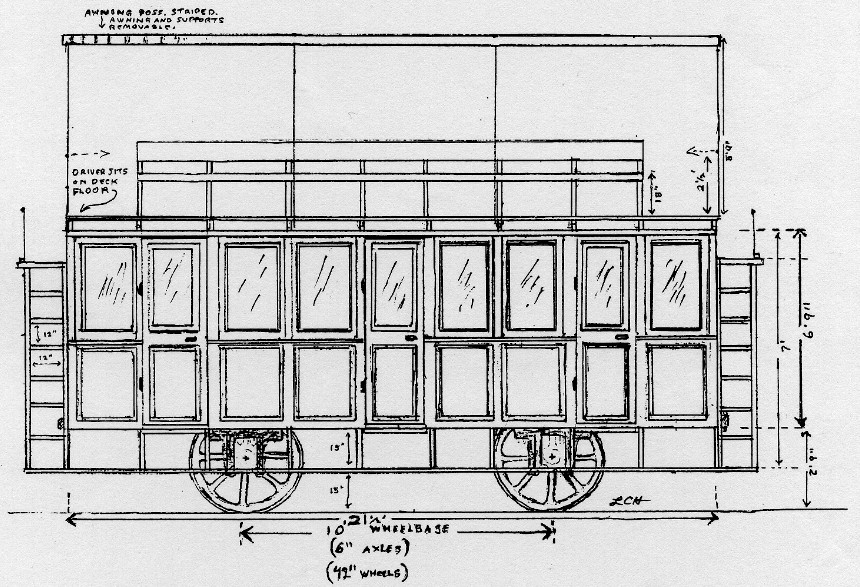

Beginning in 1835, and for over 33 years following, these sturdy double deck models were the standard streetcar of the NO&C.
In 1834, the NO&C bought the two-axle AR DD 3 CPT car named “Orleans” from the Pontchartrain RR (MP 11/11/1834), along with “RR iron” for $350 “for cost in Liverpool.” The “Orleans” was one from an order built for the PRR by the Worsdell Carriage Works — practically duplicates of many that works built for the Liverpool & Manchester Ry. for that road's 1830 inaugural. (See PRR in Trailers & Suburban Equipment section, page e, for proof the cars were DD from the start.) While the PRR cars were named, the NO&C numbered theirs, beginning with #1.
The NO&C modified (without RB the car body) the “Orleans” to be a pattern for their street railway fleet — perhaps the first such project to build a car for strictly streetcar service. (John A. Miller in his Fares Please, NY, 1941, records the New York & Harlem RR as the nation's — as well as the world's — first street railway, starting in 1832.) The NO&C Chief Engr. Charles Zimpel's modifications seemed more comprehensive than those done by the New York RR upon their RR carriages for street railway duty. For instance, Zimple installed inverted “V” steps at each of the car's ends, a running board along each side, and a back-to-back longitudinal pair of benches on the roof, with appropriate safety railings, plus a roof frame to carry canvas to protect those sitting on the roof. A powerful brake was fitted.
The NO&C initially built 10 to 15 copies of the “Orleans” at the Carrollton car maintenance and carbuilding facility. Fortunately, images exist of the cars, and there have been a few people who lived in New Orleans who have described these interesting streetcars. Christian August Lindauer, born in New Orleans 31 August 1847, was a Daily Picayune reporter, according to available city directories, from 1906 — with a short absence 1913-1915 — until his death 19 April 1916. He was quite taken by the DD “skyscrapers” and the omnibuses, publishing a detailed description in an article on early city transportation in New Orleans (DP 7/30/1911): “... The car body was divided into three compartments with seats across the cars, not longitudinally. ... The center compartment was for ladies and their escorts. The compartment at one end was for [white] men and the other for colored peoples. ... A footboard extension along the sides, on which the conductor passed around collecting his fares, then as now, five cents. But children under four years of age were charged half fare, and half fare tickets were issued.” (Fares were 10¢ until cut in half to 5¢, DP 10/29/1853.)
Lindauer continued: “The driver's seat was on top and the car's brakes engaged by his feet, the leverage being very great. When the driver put his weight on the brake, the car stopped quickly, no matter at what speed it might be moving. ... The second storey was devoted to lovers of the weed [tobacco] and was reached by narrow winding steps at each end. ... The exciting scene to witness one of them flying through the streets, the big horses stretched out like running in a race.” On neutral ground, there were planks secured to the ground to enable mules and horses to have traction during wet weather, and prevent the ground to be turned to mud. With no vehicular traffic, it would be easy to push animals beyond the 5 mph limit city ordinances required.
The charter renewal's complex problems of the 1850s saw the city government a heavy handed opponent (see NO&C streetcar section, page c, and the Lafayette & Lake Pontchartrain Ry. section in the Trailers & Suburban Equipment section, page f. City attorney John Livingston published an awful diatribe against the double deckers (DP 7/31/1854, evening edition): “I know of no special reasons for granting a renewal to this company. The right enjoyed by it has been abused. The cars, for the convenience of passengers, are of the most uncouth and inconvenient construction. It is difficult to get in and dangerous to get out of them; they are too small, too close, and not properly ventilated for this climate. Their like cannot be found on this continent. So long as the monopoly continues, so long will these cars last, and just so long will the public be compelled to travel in these hideous boxes, an endurance of twenty-nine years if the right is granted. The company should pay bonus to continue. Committee [City Council] should go further and ask that new cars be constructed according to modern notions.”
The “hideous” cars lasted another 14 years until the NO&C replaced them with the big 60-car order from Stephenson. The city attorney's attack faded and few complaints appeared, until turntables were installed at the ends of the lines, as required for the new BT cars, but the diggings of streets with holes caused inconvenience, especially for nighttime partygoers and bar patrons, who often fell into the excavations!

Copyright © 2009, 2014, 2015 Louis C. Hennick. All rights reserved.
Computer Science Department, University of Illinois at Urbana-Champaign, Home Page